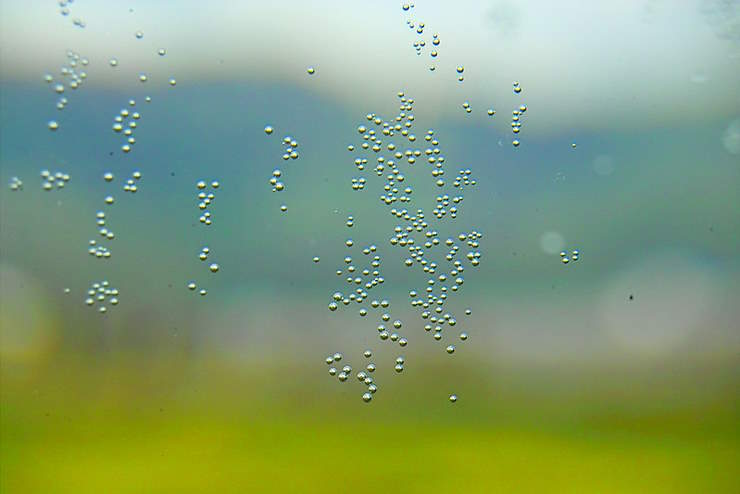Fish tank aeration creates beautiful bubbles and is crucial for maintaining a healthy aquarium ecosystem. Despite this, many hobbyists might not fully understand its importance or how it works.

In this blog post, we will explore aquarium aeration, its significance, and whether you need it for your aquarium setup.
What is aquarium aeration?
Aquarium aeration refers to increasing the oxygen levels in your aquarium water, promoting proper gas exchange between the water and the atmosphere. Aeration helps maintain a suitable oxygen concentration for your aquarium inhabitants and ensures the efficient removal of harmful gases like carbon dioxide from the water.
A common misconception is that bubbles add air to the water.
In reality, bubbles act as a mixing device. They disturb the water, causing it to move, like mixing with a spoon. This mixing ensures more water reaches the surface, where it can absorb and dissolve oxygen from the air while carbon dioxide escapes the water.
Here’s another misconception: water consists of H2O, but that doesn’t mean water contains oxygen. Oxygen as an element (O) and oxygen as a gas (O2) you can breathe are two different things.
Fish cannot breathe O from H2O, but they can and do breathe O2 dissolved in the water. Gaseous oxygen enters water when it comes into contact with the air at your fish tank’s surface. This happens because there is more O2 in the air than in the water.
Bubbling the water helps because more of the water comes into contact with air on the surface. That is what aeration does.
Why is aeration important?
Aeration is essential for several reasons:
- Oxygen supply: Fish and other aquatic creatures rely on dissolved oxygen to breathe. A well-aerated aquarium ensures that oxygen is readily available for your fish, supporting their respiration and overall health.
- Gas exchange: Aeration promotes the exchange of gases at the water’s surface, which helps remove harmful gases like carbon dioxide and ammonia while allowing oxygen to enter the water.
- Water circulation: Aeration can also improve water circulation within the aquarium, preventing stagnant areas where harmful substances might accumulate. This circulation helps maintain a uniform water temperature and promotes a healthier environment for your aquarium’s inhabitants.
- Beneficial bacteria: A well-aerated aquarium supports the growth of beneficial bacteria, which are crucial for maintaining a balanced nitrogen cycle. These bacteria help break down harmful waste products, such as ammonia and nitrite, converting them into less toxic nitrates.
How to provide proper aeration for your aquarium
There are several ways to promote aeration in your aquarium, with some of the most common methods being:
- Air pumps and air stones: This is the method you will most likely use. It is easy to install and also looks beautiful. Air pumps force air through a flexible tube connected to an air stone, releasing tiny bubbles into the water. These bubbles create water movement, promoting gas exchange at the surface.
- Sponge filters: Sponge filters provide mechanical and biological filtration and promote aeration. As water is drawn through the sponge, it creates a flow that facilitates gas exchange.
- Surface agitation: Devices such as hang-on-back filters, powerheads, or spray bars can create surface agitation, which promotes gas exchange. The water movement caused by these devices helps break up the surface tension and allows more oxygen to dissolve into the water.
- Waterfalls or water features: In some aquarium setups, waterfalls or other decorative water features can contribute to aeration. The movement and splashing of water help increase oxygen exchange at the surface.
Do you need aeration for your aquarium?
The need for aeration in your aquarium depends on various factors, such as the size of your tank, the number and type of fish, and the presence of live plants.
In most cases, some form of aeration is beneficial for your aquarium. However, if you have a densely planted tank with a low fish population, your plants may provide enough oxygen for your fish through photosynthesis, reducing the need for additional aeration.
It’s essential to monitor your fish’s behavior and the overall health of your aquarium to determine if your current aeration is sufficient or if adjustments are needed. Signs of inadequate aeration include fish gasping at the surface, lethargic behavior, or increased mortality rates.
Aeration is vital in maintaining a healthy and stable environment in your aquarium. Understanding the importance of aeration and providing the proper methods to promote gas exchange can ensure a thriving habitat for your aquatic pets.
Always monitor your aquarium’s condition and the behavior of your fish to determine if your aeration efforts are sufficient or if adjustments are needed.
Leave a Reply